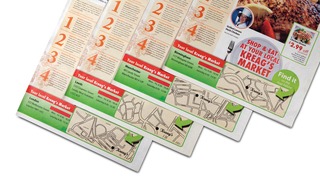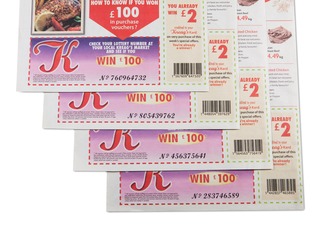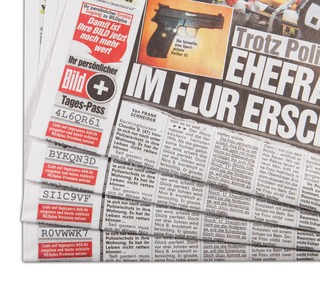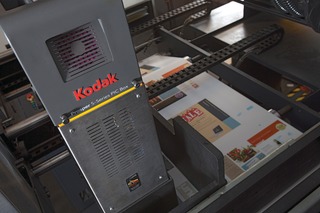Beyond Imprinting: With High-Speed Inkjet, Newspaper Publishers Can “Think Local”
Personalized/customized printing is proving to be a key application for newspapers.

It would seem like a no-brainer. Newspaper circulations are dropping, and have been since the 1980s. Personalized/customized printing is proving to be a key application for newspapers, as it is elsewhere, so you would think that digital printing, and high-speed inkjet printing in particular, would be ideal for newspaper printers and publishers. And you’d be right—except that inkjet printing of newspapers has yet to make substantial inroads in newspaper printing, at least in North America. In Europe and Asia, however, it’s not a completely different story, but different enough.
Mixing inkjet with newspaper printing is nothing new. For a long time, basic inkjet capabilities were added either inline or in finishing for addressing and perhaps to add other customized content to a newspaper printed using traditional nonheatset web offset presses. And this is still largely the role that inkjet plays in newspaper printing and publishing. This process is officially called “imprinting” and in industry parlance it is considered to be a different process than what we typically think of as “printing.”
What new inkjet printheads and high-speed printing systems have allowed, however, is what can perhaps best be thought of as “imprinting on steroids,” where entire sections of newspapers can be segmented and customized. It is also being used to create customized and interactive ads—adding QR codes or personalized URLs to newspaper ads on the fly. And all of this can be done inline at offset press speeds.
It’s Ex-Pat
One role that inkjet is playing in newspapers is in the creation of small production runs of newspapers for overseas holiday travelers and ex-patriates. It is the M.O. of a distribute-then-print model.
“On the French island of Réunion off the coast of Africa, we have a Versamark VL printer that is printing the French language newspapers that are prepared in France and distributed electronically and then printed in small to moderate quantities on the island,” said Will Mansfield, Worldwide Marketing, Kodak Inkjet. “We have similar business models in Europe, and on islands off the coast of Spain, where oftentimes foreign language titles are printed in a distribute-then-print model. On the island of Malta they are also printing the local newspapers.”
The reasons for inkjet’s growth in these newspaper markets are not a million miles removed from our own experiences close to home: circulations are decreasing, page counts are decreasing, and even page formats are getting smaller, so the overall newspaper printing requirements inch closer to the “sweet spot” for digital printing.
And that sweet spot is…?
“That’s the classic question, ‘what is the quantity?’” laughed Dario De Cian, managing director of Centro Stampa Quotidiani (CSQ) Spa, a newspaper printer based in Lombardy, Northern Italy. The real question, said De Cian, is “how many pages, not how many copies.” CSQ was founded in 2000, starting out with traditional offset newspaper presses. They started adding inkjet in 2008 and today operate an HP T230 Color Inkjet Web Press to print a mix of digital and offset newspapers, relying on inkjet for the small runs of foreign language titles for holidaymakers. De Cian said that at present digital accounts for only one to two percent of their total volume, but it’s growing, driven largely by applications that mix offset and digital sections. Namely, what De Cian calls “hyperlocal advertising.”
This is where CSQ’s investment in inserting equipment has paid off. “It’s very important to have the possibility to do inserting,” said De Cian. “We insert hyperlocal [digitally printed sections] inside the offset product and deliver it to a specific village. It is a hybrid, part is offset, part is digital.” The hyperlocal sections contain editorial and advertising unique to a specific village, town, or other geographical division.
It’s easy to see that color matching is one of the biggest challenges with this kind of workflow. “It’s important to match quality across technologies,” said De Cian. “Advertisers don’t want to see a big difference between the offset part and the digital part.”
De Cian is happy with the quality of the HP inkjet press, to the point where the decision to use offset or digital is decided on a product-by-product basis. “It’s a matter of money as well as a matter of time,” he said. “We cannot take two hours or three hours.”
Interactive Advertising
Mansfield said that many of Kodak’s Prosper customers are overseas newspaper printers using similar hybrid print processes. “You utilize the best of both worlds,” he said. “You’re utilizing a traditional newspaper printing workflow for news, for imagery, for editorial, and for most advertising, but then you’re printing segmented information into that.” With the high-speed Prosper printheads, all the customized, segmented information can be printed inline at the same speed as the rest of the paper. “Text, images, anything, at 3,000 feet per minute,” said Mansfield.
A significant application for this is gaming. For newspapers that include them, each issue has a page featuring a numbers game, and each individual copy of an issue is imprinted with a different set of numbers, so that each newspaper copy is essentially a lottery ticket. If you have the copy with the winning numbers, you win. And advertising on that gaming page can be sold at a premium since it’s a safe bet that that page will be one of the first places a reader turns.
Likewise, advertisers are also leveraging this kind of hyper-imprinting to do “interactive advertising.” It works like this. An advertiser takes out an ad and each copy features a different code in the ad. In some cases, the ad is much like a coupon which the user can take down to a retail location to receive a discount or redeem a prize. In others, it features a unique QR (Quick Response) code or PURL (personalized URL) that the user accesses online. The landing page then can capture all sorts of information about the user—plugging newspaper readers into the same types of datastreams as direct mail. Kodak offers not only the printing capabilities but also the front-end software to create these kinds of customized applications.
Newspapers themselves are also using this type of imprinting to insert custom codes in their own house ads, giving readers access to online content that is behind a paywall. Newspaper publishers that want to monetize content regardless of the delivery medium put it behind what is known as a “paywall,” sort of an Internet tollbooth. Using inkjet imprinting techniques, à la the interactive advertising approach, they can print a one-day, one-time, single-use key that varies from copy to copy and lets individual readers go online and pass through the paywall. They fill out a registration form to access desired content. “From that, the newspaper learns about who is coming through the paywall and can offer up suggested content,” said Mansfield. “The goal is not to just have them in for one day, but to subscribe to the content.”
The Last Mile Is the Hardest Mile
Thanks to inkjet printing and sophisticated front ends, a newspaper could conceivably be completely personalized. Readers could select the topics that interest them, like Google Alerts, and could then be sent their own custom newspaper. Or could they?
Actually, there is nothing technologically difficult about personalized newspapers. The idea falls down, Mansfield said, in “the last mile.” “We have the technology today to understand what a subscriber wants, we can print unique newspapers by subscriber, and get them off the press,” he said. “But newspaper distributors do not have the same approach to delivery that mail services do. We can’t guarantee that the newspaper gets off the truck to the right person.” It has nothing to do with inkjet, or printing, or technology. “The paperboy doesn’t operate in the same way the Post Office does.”
Close to Home
A lot of these hybrid and full-inkjet newspaper applications are being developed in Europe and Asia. What is preventing these kinds of applications from being more prevalent here in the States?
Mansfield says that there is some movement in that direction here at home. Largely, though, it’s stymied by the still-long run lengths of domestic newspapers—even if they are declining—as well as publishers wanting to continue utilize their current capital investments—their presses—rather than investing in new hardware.
There are other factors, not the least of which, felt Mansfield, is that the relationship with the newspaper is very different in the US than abroad. More and more US readers are content to get their news from online sources, while overseas the printed newspaper is still relatively healthy, at least for now.
The Two Great Tastes That Taste Great Together
Even if full-copy inkjet printing of newspapers has yet to scale up, publishers can leverage inkjet to pursue unique applications, especially those that mix offset and digital. “I am very bullish on the use of hybrid imprinting,” said Mansfield. “Taking inkjet and doing what it does best, and the newspaper press to do what it does best, and marrying them together. That is, you use inkjet for late-breaking news and scores and segmenting advertising circulars.” Instead of mass printing circulars for an entire city or metro region, you give the advertiser the opportunity to segment that area, and print versioned circulars that are distributed in smaller sections of that area, such as around individual Home Depot or Lowe’s locations—the “hyperlocal” approach. And with inkjet, said Mansfield, “the printer doesn’t have to stop the press to change plates to do this. It’s all inline.”








